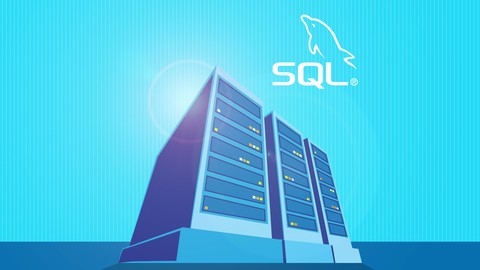T-SQL (Transact-SQL) is the primary programming language for interacting with Microsoft SQL Server databases.
It’s a powerful tool for data professionals, enabling them to manage, manipulate, and analyze data efficiently.
By learning T-SQL, you can build complex queries, automate tasks, create stored procedures, and gain valuable skills highly sought after in the job market.
Whether you’re aspiring to be a database administrator, data analyst, or developer, T-SQL proficiency is a crucial asset.
Finding the perfect T-SQL course on Udemy can be overwhelming.
With a vast selection of courses available, it’s essential to choose one that aligns with your learning style, experience level, and career goals.
You’re searching for a course that not only covers the fundamentals but also provides practical exercises and real-world examples to solidify your understanding.
Based on our in-depth analysis, we’ve identified Learn T-SQL From Scratch For SQL Server Administrator as the best overall T-SQL course on Udemy.
This comprehensive course takes you from beginner to confident SQL Server administrator, guiding you through the fundamentals of T-SQL, database administration, and practical application.
With its clear explanations, hands-on exercises, and focus on real-world scenarios, it’s an excellent choice for anyone looking to master T-SQL for database administration.
However, if you’re seeking a course with a different focus or teaching style, we have other great options to consider.
Keep reading to explore our curated list of T-SQL courses on Udemy, tailored to various learning preferences and skill levels.
Learn T-SQL From Scratch For SQL Server Administrator
This course takes you from beginner to confident SQL Server database administrator.
You start with the fundamentals, learning what T-SQL is and how to use it.
The course guides you through setting up your environment, including installing SQL Server 2017 and using the AdventureWorks2017 database.
You then dive into basic T-SQL commands like SELECT, WHERE, LIKE, and ORDER BY, learning how to retrieve and filter data.
You also discover how to add, change, and remove data from tables using INSERT, UPDATE, and DELETE.
As you progress, you learn to create and manage databases and tables.
You discover how to control data with constraints and use joins to combine information from multiple tables.
You explore powerful features like aggregates, which help you summarize data, and learn to handle NULL values effectively.
The course then introduces more advanced techniques, including subqueries, data types, and functions for working with text and dates.
You’ll also learn how to create and use views, indexes, and stored procedures to make your databases run efficiently.
Finally, you delve into SQL Server Administration.
You discover how to use tools like SQL Server Management Studio and SQL Server Express 2012 and explore the differences between SQL Server 2014 and SQL Server 2017.
You gain experience working with different versions like SQL Server 2019 and practice using sample databases like AdventureWorks2012.
The course teaches you to manage security, backups, and performance, giving you a solid foundation in database administration.
SQL Server: Learn T-SQL in 9 hours (ITS-201, ITN-201,98-364)
The course begins with basic SQL Server concepts, covering things like rows, columns, and types of data.
You start writing simple queries using the SELECT statement to retrieve data from tables.
This gives you a foundation for learning to filter data with the WHERE clause, group data with GROUP BY, and arrange results with ORDER BY.
You will also discover how to use JOIN statements to combine information from multiple tables.
The course then teaches you how to design your own tables, including concepts like data types, primary keys, foreign keys, and normalization.
You learn to use Data Manipulation Language (DML) to add, change, and remove data from tables.
You also discover how to use Data Definition Language (DDL) to create and manage parts of the database, like views, stored procedures, and functions.
You will then learn about advanced topics like different types of joins, such as INNER JOIN and LEFT JOIN.
The course covers database security, teaching you about things like user accounts and roles.
You learn how to grant and revoke permissions to protect your database.
Finally, you learn about different types of backups and how to restore a database to a previous state.
Learn Advanced T-SQL For SQL Server Administrator
This course equips you with the skills to write efficient and powerful SQL code using stored procedures.
You’ll begin by setting up your learning environment, installing SQL Server 2014, and getting acquainted with the Adventureworks database.
This hands-on approach allows you to apply your knowledge in a practical setting right from the start.
You’ll then dive into the core of the course: mastering stored procedures.
You’ll learn to create, modify, and delete them, along with essential techniques like using input parameters, variables, and control flow mechanisms like IF-ELSE statements and loops.
The course guides you through using cursors and transactions, providing a solid understanding of data manipulation within your stored procedures.
You’ll explore more advanced techniques such as error handling and working with table variables and derived tables.
The course goes beyond the basics, introducing you to Common Table Expressions (CTEs) for breaking down complex queries into manageable parts.
You’ll also discover how to leverage the power of Power BI to visualize and analyze your data, adding a valuable dimension to your skillset.
Microsoft SQL for beginners : ( MS-SQL Server,T-SQL, SSMS )
You’ll start by setting up your environment, learning how to install SQL Server and SQL Server Management Studio (SSMS).
The course then dives into the core concepts of SQL and Transact-SQL (T-SQL), the language used to interact with SQL Server.
You’ll gain a clear understanding of database structure, learn how to create and manage databases and tables, and master the essential CRUD operations: creating, reading, updating, and deleting data.
Beyond the basics, the course covers advanced techniques for manipulating data.
You’ll learn how to filter and sort data using various comparison operators and logical expressions, enabling you to extract specific information from your database.
You’ll also explore the power of joins, allowing you to combine data from multiple tables for a more comprehensive view.
The course then introduces you to aggregate functions, such as COUNT, AVG, MAX, MIN, and SUM, along with the GROUP BY clause, enabling you to analyze data in meaningful ways.
The course’s practical approach ensures you gain hands-on experience with real-world scenarios, preparing you to effectively manage and manipulate databases in various applications.
T-SQL Training with Real World Scenarios:Tricks of the Trade
You’ll start with the fundamentals, like navigating SQL Server Management Studio (SSMS) and mastering database manipulation language (DML) tricks.
You’ll discover how to effortlessly drop multiple tables, update and delete data like a pro, and switch between different SQL Servers without breaking a sweat.
The course then plunges into the exciting world of Window Functions.
You’ll explore ranking functions such as RANK, DENSE_RANK, and ROW_NUMBER to analyze and organize data with ease.
You’ll become proficient with aggregate functions like SUM, MIN, MAX, COUNT, and AVG, making complex calculations a breeze.
The course even throws in real-world scenarios to help you apply these concepts, ensuring you’re job-ready.
Next, you’ll unlock the power of Common Table Expressions (CTEs) and Recursive CTEs, mastering techniques to structure and reuse complex queries.
You’ll learn how to use these powerful tools for tasks like generating date dimensions.
The course also introduces you to the Coalesce Function, a handy tool to handle missing data, and the Merge command, which allows you to seamlessly merge changes into existing tables.
Finally, you’ll delve into the world of Stored Procedures, discovering how to create efficient, reusable SQL code.
The course teaches you the importance of error handling with techniques like THROW and RAISERROR, ensuring your code is robust and reliable.
You’ll discover the power of batches for efficient execution and learn to implement pagination using OFFSET FETCH to handle large datasets.
The course wraps up by teaching you how to use Synonyms to simplify table renaming and introduces Table Valued Stored Procedures, a powerful tool to optimize database performance.
Advanced T-SQL: Window Functions for Advanced Querying
This course on advanced T-SQL focuses on window functions and how they empower you to write better queries.
You begin by setting up your environment and restoring a database.
This ensures you have everything you need to start learning right away.
Then, you dive into ranking functions like ROW_NUMBER, RANK, DENSE_RANK, and NTILE.
These functions are incredibly useful when you need to categorize your data and understand its order.
Next, you’ll discover the power of window aggregate functions.
You’ll learn how to use them with frames, giving you precise control over how you summarize your data.
Imagine you want to calculate a running total or a moving average; window aggregate functions make these tasks a breeze.
The course then takes you into the world of window offset functions, including LAG, LEAD, FIRST_VALUE, and LAST_VALUE.
With these functions, you can easily access and compare data from different rows, revealing hidden patterns and trends.
Finally, you learn about window statistical functions like PERCENT_RANK, CUME_DIST, PERCENTILE_CONT, and PERCENTILE_DISC.
These functions equip you with powerful tools to understand the distribution of your data.
Microsoft SQL Server And T-SQL Course For Beginners
You’ll begin by setting up your own environment.
This includes downloading and installing both SQL Server 2017 and SQL Server Management Studio 18.3.1 (SSMS).
Once you are set up, you dive into how data is structured and stored in SQL Server.
You learn about the importance of indexes and what it means for a database to be relational.
Next, you discover Data Definition Language (DDL) and how to use these commands.
You learn how to create, modify, and even drop tables.
You discover the importance of data normalization and how to design efficient databases.
Then, you move on to Data Manipulation Language (DML) commands, learning how to retrieve data using different techniques like scalar functions and sorting.
You learn to manipulate this data and pull out important insights using joins, aggregate functions, and even subqueries.
You then advance to Data Control Language (DCL) commands and learn to grant and revoke permissions for database security.
Finally, you can put all of your newfound knowledge to the test!
You tackle realistic scenarios where you filter data, update entries with joins, summarize information, count groups, and much more.
You even get to experiment with a real-world dataset, the Adventure Works Database, to further solidify your understanding.
Introduction to T-SQL for Data Analysts
This course equips you with the ability to write queries that extract valuable insights from databases.
You will begin by mastering the fundamentals of T-SQL and its interaction with Microsoft SQL Server.
This foundation allows you to create your own databases and tables, essential skills for organizing and storing data.
The course then guides you through writing simple queries to retrieve specific information from these databases.
You will learn to filter data, group it according to your needs, and even combine data from multiple tables using joins.
As you progress, you’ll discover how to create views and stored procedures, simplifying complex operations and making your code more efficient.
You will also gain practical knowledge on managing databases effectively, including aspects of security and organization.
Finally, the course points you towards valuable resources such as the T-SQL forum on MSDN, where you can find support from a community of users and further enhance your skills through real-world practice.








